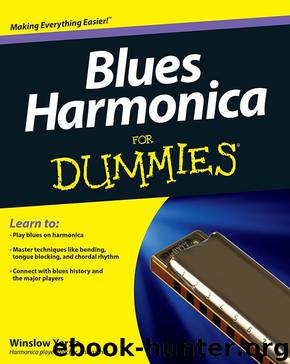Blues Harmonica For Dummies by Yerxa Winslow

Author:Yerxa, Winslow [Yerxa, Winslow]
Language: eng
Format: epub, azw3
Publisher: Wiley
Published: 2012-07-20T00:00:00+00:00
Tab 10-2: Tongue vamping.
You can hear and play along with Tab 10-2 on Track 44.
Pull-offs
Pull-offs are similar to vamps but incorporate two refinements:
Pull-offs are brief and percussive.
A pull-off can be in a different breath direction and in a different hole from the single note that precedes it. For instance, you might follow Blow 4 with a pull-off in Draw 1, 2, and 3.
Here’s how you play an inhaled pull-off:
1. Play a single note with your tongue on the harp.
2. Close the gap between the right edge of your tongue and the right corner of your mouth so that all the holes are blocked, and then start to inhale.
Because your tongue is blocking all the holes, a tiny amount of suction builds up.
3. Retract your tongue and allow all the holes in your mouth to sound.
The sudden release of built-up air suction creates a percussive effect.
4. Quickly cut off the sound by closing your throat.
You do this the same way you make the sound “uh” when you say, “uh-uh.” (This is called a glottal stop. I cover glottal stops in detail in Chapter 9.)
When you play a pull-off, you perform Steps 2, 3, and 4 almost instantaneously. Getting the hang of this can take some time, but the result is worth it.
Tab 10-3 is a 12-bar blues that uses pull-offs. Because each pull-off may be in a different breath direction and hole from the melody note that precedes it, I can’t use a shorthand symbol to show the pull-off. Instead, I show each pull-off as a separate chord, with a dot above the tabbed note to indicate the glottal stop cutoff.
You can hear and play along with Tab 10-3 on Track 45.
You can hear pull-offs used to devastating effect by Sonny Boy Williamson II (also known as Rice Miller) on his classic recording of “Help Me.”
Tongue slaps
When you play a tongue slap, you slap your tongue onto the harmonica as a way of starting a single note. So a tongue slap is sort of the opposite of a pull-off.
Imagine that you’re about to play Draw 4 with a tongue block but you forget to put your tongue on the harp and you get a chord instead. Thinking quickly, you recover almost instantly and slap your tongue down on the harp to sound that isolated Draw 4. But you still hear a chord very briefly, as if the chord was a way of starting the note. That’s the effect you get when you play a tongue slap. Figure 10-3 shows the sequence of tongue placement for a slap.
Download
This site does not store any files on its server. We only index and link to content provided by other sites. Please contact the content providers to delete copyright contents if any and email us, we'll remove relevant links or contents immediately.
The Goal (Off-Campus #4) by Elle Kennedy(13207)
Kathy Andrews Collection by Kathy Andrews(11331)
Diary of a Player by Brad Paisley(7270)
What Does This Button Do? by Bruce Dickinson(5936)
Assassin’s Fate by Robin Hobb(5858)
Big Little Lies by Liane Moriarty(5519)
Altered Sensations by David Pantalony(4872)
Pale Blue Dot by Carl Sagan(4627)
Sticky Fingers by Joe Hagan(3916)
The Death of the Heart by Elizabeth Bowen(3342)
The Heroin Diaries by Nikki Sixx(3325)
Beneath These Shadows by Meghan March(3153)
Confessions of a Video Vixen by Karrine Steffans(3104)
The Help by Kathryn Stockett(3022)
How Music Works by David Byrne(2968)
Jam by Jam (epub)(2880)
Harry Potter 4 - Harry Potter and The Goblet of Fire by J.K.Rowling(2814)
Strange Fascination: David Bowie: The Definitive Story by David Buckley(2702)
Petty: The Biography by Warren Zanes(2575)
